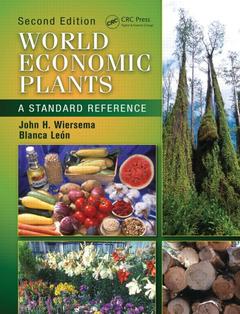World Economic Plants (2nd Ed.) A Standard Reference, Second Edition
Auteurs : Wiersema John H., León Blanca

Given the frequent movement of commercial plants outside their native location, the consistent and standard use of plant names for proper identification and communication has become increasingly important. This second edition of World Economic Plants: A Standard Referenceis a key tool in the maintenance of standards for the basic science underlying the quest for security of food and other economic plant resources. Containing a substantial increase in content from the previous edition, this comprehensive and accessible work now documents more than 12,000 economically important vascular plants.
This volume covers plants and plant products that are traded, regulated, or otherwise important to international commerce. The plant names and uses have been meticulously checked against the literature and by external peer reviewers, and names are up to date in their taxonomic classification and nomenclaturally correct according to international rules. Each entry includes the accepted scientific (Latin) name, synonyms, economic importance, common names in a variety of languages, and the geographical distribution of the species. The information on each plant can be accessed through either its scientific or common name, providing a global perspective on its native, introduced, or cultivated geographical distribution, and its economic usage or impacts.
This reference covers all major groups of economic plants, including those used for human or animal food, materials, medicines, environmental purposes, gene sources for breeding, social purposes, as well as ones with negative impacts such as poisonous or disease-harboring plants or weeds. This compilation provides scientists, professionals, and students from various backgrounds with a global standard for communication regarding economically important plants. As collaboration across plant science increases, comprehensive standardized references such as this one are indispensible for addressing the global issues involved with agriculture and other human uses of plant diversity.
New this edition:
- Includes over 25 percent more economic plants?approximately 2,700 new plants
- Comprises twice the data content of the first edition
- Contains more than 50,000 common names in all principal world languages, now including some in their original scripts
Introduction. Discussion of Content. Scientific Names. Synonymy
Common Names. Economic Importance. Geographical Distribution. Symbols and Abbreviations. References Cited. Acknowledgmetns. List of Reviewers. Catalog of Economic Plants. Indices of Common Names: Latin Script Languages. Non-Latin-Script Languages.
John H. Wiersema, Ph.D., has worked to develop an extensive and exhaustive taxonomic resource on economic plants, especially those important to global agriculture, for nearly 30 years. This activity has been carried out as the curator of taxonomic data for the USDA’s national germplasm system’s GRIN database. Through this work, Dr. Wiersema has gained global standing as a specialist in plant nomenclature, and now has direct editorial involvement with both the botanical and cultivated plant codes of international nomenclature and the international nomenclature journal Taxon. Dr. Wiersema is also well known as a specialist on the taxonomy of the water-lily family, and is responsible for the discovery and description of several new species and over 30 scientific publications on the group.
Blanca Leon, Ph.D., is a plant taxonomist by training. She worked with John H. Wiersema from 1994 to 2000 with the USDA GRIN database and later joined the GRIN taxonomy team to work on projects related to the goals of the USDA’s national germplasm system. She is currently involved in developing with Dr. Wiersema a detailed overview of crop relatives. Dr. Leόn has extensive field work experience in tropical Andean South America. These experiences are manifested in her work both for projects like this book and also for her undertaking of the evaluation of the conservation status of endemism in a tropical country. Her research also deals with fern taxonomy, mainly of Neotropical Polypodiaceae, and with the biogeography of fern taxa. She has over 60 publications in different botanical journals.
Date de parution : 02-2013
21x28 cm



